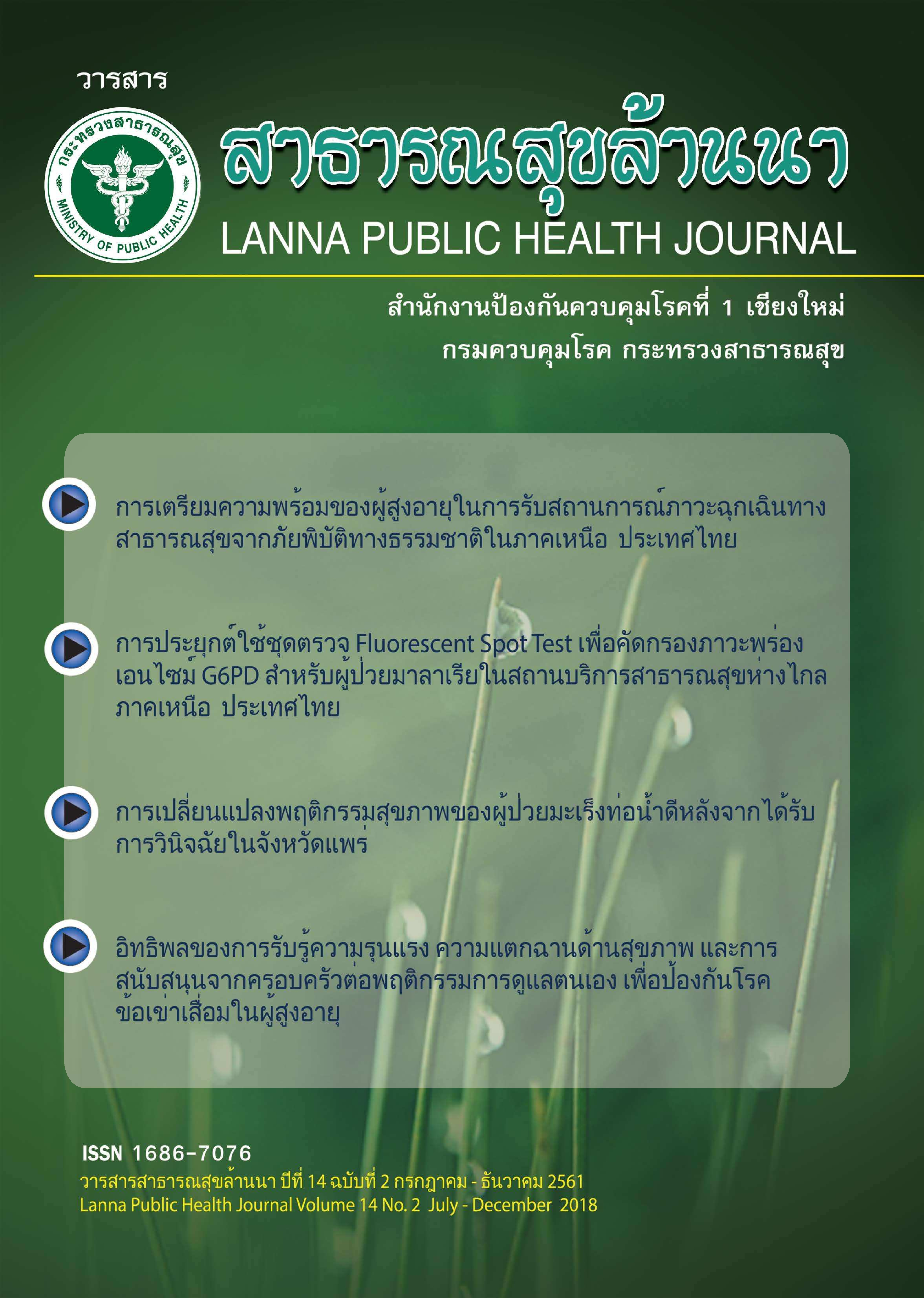การประยุกต์ใช้ชุดตรวจ Fluorescent Spot Test เพื่อคัดกรอง ภาวะพร่องเอนไซม์ G6PD สำหรับผู้ป่วยมาลาเรียใน สถานบริการสาธารณสุขห่างไกล ภาคเหนือประเทศไทย
คำสำคัญ:
ภาวะพร่องเอนไซม์จีซิกพีดี, ผู้ป่วยมาลาเรีย, มาลาเรียไวแวกซ์, ชุดตรวจ G6PD, มาลาเรียฟัลซิปารัม สำเร็จรูปบทคัดย่อ
การวิจัยนี้มีวัตถุประสงค์เพื่อพัฒนาชุดตรวจคัดกรองภาวะพร่องเอนไซม์ G6PD ด้วยวิธีมาตรฐานสำหรับผู้ป่วยที่มารับบริการการตรวจวินิจฉัยและรักษาในมาลาเรียคลินิกในพื้นที่จังหวัดแม่ฮ่องสอน ยา primaquine เป็นยาชนิดเดียวที่ใช้ในการรักษาผู้ป่วยมาลาเรียชนิดไวแวกซ์แบบหายขาด และฆ่าเชื้อระยะมีเพศสำหรับเชื้อมาลาเรียทุกชนิด แต่ยาชนิดนี้มีผลทำลายเซลล์เม็ดเลือดแดงในผู้ป่วยมาลาเรียที่มีภาวะพร่องเอนไซม์ G6PD ทำให้มีความเสี่ยงต่อภาวะโลหิตจางซึ่งอาจรุนแรงและเสียชีวิตได้ ดังนั้นผู้ป่วยมาลาเรียทุกรายจะได้รับการตรวจคัดกรองภาวะพร่องเอนไซม์
G6PD มีผู้ป่วยที่ได้รับการตรวจคัดกรอง G6PD ด้วยวิธี modified FST G6PD และวิธี CareStartTmG6PD RDT ที่ใช้เป็นงานประจำ จำนวนสิ้น 109 ราย ผลการตรวจด้วยวิธี modified FST มีค่าความไว และความจำเพาะ เท่ากับ 100 เมื่อเปรียบเทียบกับวิธี Methylene blue Oxidation ในจำนวนนี้มีผู้ที่เอนไซม์ G6PD ปกติ 104 ราย (95.41%) มีภาวะพร่องเอนไซม์ G6PD 4 ราย (3.67%) และพร่องเอนไซม์บางส่วน 1 ราย (0.93%) สำหรับผลการภาวะพร่องเอนไซม์ ด้วยชุดตรวจ CareStartTmG6PD RDT พบว่าแปลผลไม่ได้ จำนวน 39 ราย (35.78%) จึงไม่สามารถคำนวณหาค่าความไว ความจำเพาะ และค่าความถูกต้องของชุดตรวจได้ ซึ่งอาจเกิดจากหลายสาเหตุ แต่สาเหตุหนึ่งอาจเกิดจากความเข้มข้นของเลือดสูง และอุณหภูมิในพื้นที่ที่ค่อนข้างสูง ทำให้เลือดไม่สามารถไหลซึมผ่านแผ่นตรวจ โดยสรุปการศึกษานี้แสดงให้เห็นชัดเจนว่าวิธี modified FST G6PD ที่พัฒนาขึ้นนี้สามารถการตรวจคัดกรองภาวะพร่องเอนไซม์ใช้ในพื้นที่ห่างไกล โดยให้เจ้าหน้าที่ปฏิบัติหน้าที่ในพื้นที่เป็นผู้ดำเนินการตรวจเองได้
เอกสารอ้างอิง
Ainoon, O., Alawiyah, A., Yu, Y. H., Cheong, S. K., Hamidah, N. H., Boo, N. Y., & Zaleha, M. (2003). Semiquantitative screening test for G6PD deficiency detects severe deficiency but misses a substantial proportion of partially-deficient females. Southeast Asian J Trop Med Public Health, 34(2), 405-414.
Avalos, S., Mejia, R. E., Banegas, E., Salinas, C., Gutierrez, L., Fajardo, M., et al. (2018). G6PD deficiency, primaquine treatment, and risk of haemolysis in malaria-infected patients. Malar J, 17(1), 415. doi: 10.1186/s12936-018-2564-2.
Espino, F. E., Bibit, J. A., Sornillo, J. B., Tan, A., von Seidlein, L., & Ley, B. (2016). Comparison of Three Screening Test Kits for G6PD Enzyme Deficiency: Implications for Its Use in the Radical Cure of Vivax Malaria in Remote and Resource-Poor Areas in the Philippines. PLoS One, 11(2), e0148172. doi: 10.1371/journal.pone.0148172.
Henriques, G., Phommasone, K., Tripura, R., Peto, T. J., Raut, S., Snethlage, C., et al. (2018). Comparison of glucose-6 phosphate dehydrogenase status by fluorescent spot test and rapid diagnostic test in Lao PDR and Cambodia. Malar J, 17(1), 243. doi: 10.1186/s12936-018-2390-6.
Jiang, J., Ma, X., Song, C., Lin, B., Cao, W., Wu, S., & Hsiao, K. J. (2003). Using the fluorescence spot test for neonatal screening of G6PD deficiency. Southeast Asian J Trop Med Public Health, 34 Suppl 3, 140-142.
Luzzatto L., P. V. E. G.-p. d. d. I. O. S. H., Nathan D.G., Ginsburg D., Look A.T., Fisher D.E., Lux S. IV, editors. Nathan and Oski’s Hematology of Infancy and Childhood. Saunders; Philadelphia, PA, USA: 2009. pp. 883–907.
Nadarajan, V., Shanmugam, H., Sthaneshwar, P., Jayaranee, S., Sultan, K. S., Ang, C., et al. (2011). Modification to reporting of qualitative fluorescent spot test results improves detection of glucose-6-phosphate dehydrogenase (G6PD)-deficient heterozygote female newborns. Int J Lab Hematol, 33(5), 463-470. doi: 10.1111/j.1751-553X.2011.01309.x.
Phompradit, P., Kuesap, J., Chaijaroenkul, W., Rueangweerayut, R., Hongkaew, Y., Yamnuan, R., et al.. (2011). Prevalence and distribution of glucose-6-phosphate dehydrogenase (G6PD) variants in Thai and Burmese populations in malaria endemic areas of Thailand. Malar J, 10, 368. doi: 10.1186/1475-2875-10-368.








